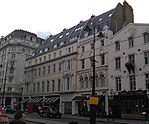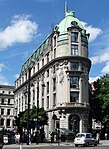Lancaster Place
London stubsStreets in the City of WestminsterUse British English from June 2015

Lancaster Place is a short section of road in central London, which connects Waterloo Bridge to the major junction with the Aldwych and Strand. It is completely bisected by the northbound-only Strand Underpass which dives below the Aldwych enabling Kingsway-bound traffic (and single-decker bendy buses on the bus route 521) to skip the "fiveways" junction. Brettenham House and the more famous Somerset House front onto the West and East sides of Lancaster Place respectively.
Excerpt from the Wikipedia article Lancaster Place (License: CC BY-SA 3.0, Authors, Images).Lancaster Place
Lancaster Place, London Covent Garden
Geographical coordinates (GPS) Address Nearby Places Show on map
Geographical coordinates (GPS)
| Latitude | Longitude |
|---|---|
| N 51.5105 ° | E -0.1187 ° |
Address
Lancaster Place
Lancaster Place
WC2E 7ED London, Covent Garden
England, United Kingdom
Open on Google Maps









